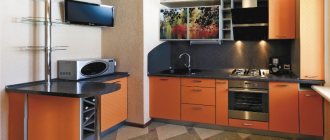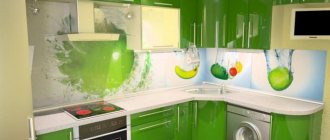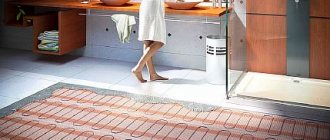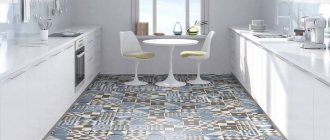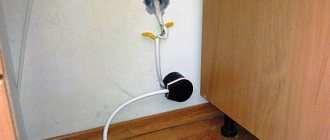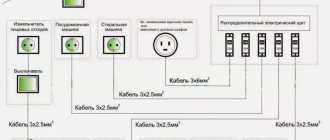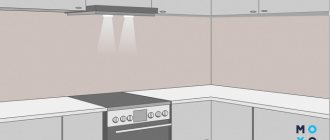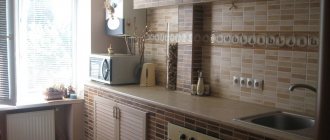Why do you need ventilation in the kitchen?
When cooking food, various harmful substances accumulate in the kitchen.
Some of them may be hazardous to human health. One of these is carbon monoxide, which accumulates in the air after the combustion of “blue fuel” or when cooking food in a wood-burning stove. Its smell is not noticeable, and the substance itself cannot be properly selected by carbon filters. High concentrations of carbon monoxide lead to poisoning and then death. This is why it is important to develop an effective kitchen air exchange system and remove this hazardous product. When you turn on the burner of a gas stove, as well as when the water heater is operating, a certain amount of natural gas that has not had time to burn gets into the interior space of the room. Properly functioning natural ventilation installed in the kitchen can easily cope with such emissions, but its power will not be enough if fuel leaks from the pipelines. If you detect a persistent odor of ethyl mercoptane, you must call emergency services.
There are other substances that pollute the air in the kitchen:
- Fumes from frying foods are released in the form of processed particles of fat and sunflower oil. As a result of strong heating, such substances become dangerous for the inhabitants of the house; they settle on the walls of the room, dishes and furniture, as well as on our lungs. To effectively remove such particles, it is necessary to select the correct size of ventilation in the kitchen.
- In addition to the fumes, water vapor is released in the room. It is relatively harmless, but can affect the indoor climate.
From the above, the only correct conclusion can be drawn about the need to use a high-quality ventilation system. It will remove kitchen odors and excess moisture.
Beneficial features
High-quality built-in ventilation for the kitchen has a number of advantages, including a reduction in the following influencing factors:
- Unpleasant child.
- Evaporation of water.
- Removing odors.
Most dishes require a process of cooking or stewing, which introduces moisture into the air. The steam gradually settles in the room and turns into water droplets, which, in turn, fall on the walls and window slopes.
If left unchecked, mold or mildew will develop and your wood furniture may deteriorate or last much less time. When heated, oils and fat release certain substances and settle on the floor and textiles, and if this happens in all rooms at once, disastrous consequences cannot be avoided.
Natural and forced ventilation in the kitchen – what to choose?
The answer is obvious - it is best when both types of ventilation in the kitchen are available and work in tandem. Natural ventilation in a kitchen with a gas stove is especially necessary. Despite their common purpose, these two types of hoods most often cannot replace each other. Without proper natural ventilation, the air in the room can only be purified when forced exhaust is turned on, which is why harmful substances and excess moisture are simply not removed in full.
However, having a working, correctly installed natural hood, you can already be completely calm about your safety. Forced ventilation is more likely to be responsible for comfort, since it can be turned on as soon as necessary to remove unwanted odors and fumes from the room.
Naturally ventilated kitchen with gas stove
If you have a gas stove, a small excess of natural gas is produced; natural ventilation successfully removes it and prevents it from accumulating. For prevention, it is necessary to periodically check the ventilation duct for the presence of sufficient draft - to do this, simply attach a piece of paper to the hole. If it sticks, the traction is satisfactory.
Advantages of natural hood in the kitchen:
- Continuous, uninterrupted operation
- Providing general ventilation of the room, in combination with ventilation ducts in bathrooms
- Good removal of all types of dangerous fumes and excess moisture. Acceptable removal of unpleasant odors
- No additional installation costs or electricity usage required
- Operation is absolutely silent and does not cause any discomfort to residents
Despite many positive factors, it also has a number of disadvantages:
- There may be a decrease in the efficiency of the hood in the hot season, after prolonged frosts.
- In the presence of a number of unfavorable conditions, reverse draft is possible, when air begins to flow from the street into the room, and not vice versa
- The volume of air removed by the hood per unit of time is quite small, which is why kitchen hoods often cannot cope with unpleasant odors that arise during cooking.
- For proper operation of the hood, a normal flow of air from outside is necessary. Modern metal-plastic windows are sealed hermetically and cannot provide a normal volume of air outside. Therefore, you must remember to open the windows while cooking.
- The ventilation duct may be clogged with snow or debris. Neighbors who have removed the ventilation shaft for some reason may block the duct for other residents
- It is necessary to regularly monitor the draft level and, if necessary, clean the channels
Forced ventilation in the kitchen: advantages and disadvantages
The undoubted advantage of a forced ventilation system is its high performance, which allows you to quickly clean the air in the room.
By installing a forced hood directly above the hob, harmful volatile substances are removed before they spread throughout the kitchen.
Among the main disadvantages of forced ventilation it is necessary to mention:
- Higher cost compared to the natural ventilation option.
- Dependence of operation on the constant availability of electricity in the network.
- The presence in the design of mechanical equipment that can occasionally fail.
- High noise level of the operating fan.
Installation of a ventilation system with natural air flow
The kitchen ventilation system in an apartment in a multi-storey building has certain advantages in comparison with the ventilation operating conditions in the kitchen of private housing construction:
- The section of the ventilation pipe rising from the kitchen to the roof is located at a height of at least 16-18 m. A decent height provides two to three times greater level of natural draft than in the pipe of a one or two-story house;
- The kitchen ventilation shaft is combined into one package with ducts from other apartments; the entire shaft is closed and isolated from the outside atmosphere. As a result, the polluted air remains warm for a long time and is guaranteed to rise to the emission point on the roof.
Tall pipes provide a sufficient level of vacuum in the kitchen ventilation system, but this is not enough. The presence of draft in itself is always welcome, but you also need to be able to correctly configure the operation of natural ventilation.
Standards and requirements for kitchen exhaust systems and installation
Exhaust systems, like any other equipment, are subject to installation requirements and technical characteristics:
- Match the size of the exhaust system and the gas stove underneath for maximum efficiency in removing odors.
- The hood must be installed no less than 50-60 cm from the stove. This is done for ease of use. In addition, if the hood is lowered too low, there is a high probability that the fat accumulated on it will ignite.
- The capacity of the hood should replace air at least 10 times per hour. To calculate how much volume the exhaust system should process, you need to take into account the area and height of the ceilings in the kitchen. Calculate using the formula: V = S * h * 10 * 1.3, where S and h are the area and height of the room, respectively, 12 is the minimum air treatment rate in 60 minutes, 1.3 is the correction factor.
- If there is no veterinary duct in the kitchen, then it is better to install the hood with the ability to adjust the performance and recirculation. If you connect a flow hood to natural ventilation, this will lead to disruption of the latter. Also, you should not turn on such devices for a long time.
- Craftsmen must strictly follow the instructions in the equipment passport.
- The hood is leveled.
- Turns at an obtuse angle are not allowed; any turns should be as few as possible.
- If the length of the route exceeds 300 cm, then a second exhaust fan is required.
- There is no need to choose equipment with high power, it makes a lot of noise, and it is not intended for residential premises.
Undeniable disadvantages
Such silent ventilation for the kitchen is not entirely ideal; with the onset of heat, the system noticeably slows down and does not work at full capacity due to the normalization of temperatures. If you do not open the windows, then the opposite effect may occur; air will flow from the exit into the apartment, and not vice versa.
Removing steam and soot cannot be called the most productive; some elements go away, but not all. If you use the entire cooking surface, the negative impact cannot be avoided; only moderate use of pans and pots can be done by the natural system.
What to choose: hood or fan
To choose the right model for kitchen ventilation, you need to consider the following parameters:
- Performance. According to building and sanitary standards, the exhaust system in the kitchen must support a tenfold replacement of the air available in the room. This means that the total replacement volume must exceed the cubic capacity of the kitchen by 10 times. You also need to add 30% just in case. The result will be the required power that suits a specific kitchen. The quality of natural ventilation draft also influences the determination of performance. If its level is high, low-power models are also suitable, but in case of insufficient traction, an option with higher performance is needed.
- Noise level. The optimal level here is 35 dB, which is slightly higher than a whisper (30 dB). The noise directly depends on the fan power. The quiet option is suitable for the kitchen.
- Terms of Use. If the fan is located in the hood above the stove, it needs reliable protection from high temperatures. Many units are coated with heat-resistant compounds.
- Additional features. Some hoods, in addition to their direct function, are also supplemented with programmable timers, human presence sensors and other options that significantly increase ease of use.
Remember that any additional functions increase the cost of the equipment and reduce the duration of its trouble-free operation.
When choosing a hood, consider its design so that it looks harmonious and beautiful in the interior.
Can a range hood decorate the kitchen? Of course, as long as it is chosen wisely and looks impeccable and stylish!
Advantages of the natural version
High-quality ventilation in the kitchen with a hood of this type is always in working order, it does not break down and does not depend on electricity. The main substances that are released during the cooking process leave through it.
In small quantities, gas leakage from the oven is not a problem, and if the cooking is not too intense, the vapors will also escape.
Saving money will be a pleasant addition, because in most houses built according to SNiP, such a system has already been introduced from the very beginning. It works autonomously and for it to work properly you just need to clean the communications on time.
No unnecessary noise is created, since additional fans are not needed for operation, and family members will not hear the sound of the device.
Note!
- Kitchen with gas stove: design features, photos of the finished renovation
How to make a kitchen with your own hands - examples of beautiful and modern renovations
Assembling a kitchen - step-by-step DIY assembly guide, necessary materials and tools
What types of hoods are there in the kitchen?
There are many options for hoods on sale, which can be selected in detail for certain operating conditions. They have significant differences, among which the following areas are especially distinguished:
- According to the cleaning method.
Here there are evacuation and circulation options, where the first one is connected to the air duct and removes harmful substances and unpleasant odors outside. This option is protected by a backdraft valve. The second option includes a carbon-type filter in its design, thanks to which the kitchen ventilation in the house purifies the air without any contact with the external environment.
- According to design features.
The appearance of the device is very important, since everyone needs it to fit perfectly into the design of the kitchen, look aesthetically pleasing, be easy to clean, and also its installation takes a minimum of time, without the involvement of third-party specialists. There are domed and built-in options here. Dome has this name due to the shape of the air exchanger.
The pyramidal filter passes the outgoing air through itself and releases it out through a special hole through a pipe. A built-in hood is often hidden in furniture that is made to order. It is distinguished by ergonomics, saving space, but at the same time, convenient process management.
According to the method of purifying air masses
There are many ways to purify the air in the kitchen.
Depending on which of them is used in a particular model, hoods are divided into:
- Evacuees. These models exhaust air from the kitchen outside through air ducts made in the form of a metal box or corrugated pipe. For such a device to work, there must be a ventilation duct or a simple hole. Usually the air duct is equipped with a valve that prevents the occurrence of reverse draft.
- Circulating. This model has a carbon filter, similar to a gas mask. In fact, this is not a hood, but a filtering unit that purifies the air from the main “odors”: there is no air exchange with the external environment. Such a device is attractive due to its simplicity of installation, but it is not able to protect, for example, from gas leaks.
Circulating hoods can be adjacent to standard kitchen ventilation. Their disadvantages usually include high cost and expensive maintenance: carbon filters require periodic replacement.
The circulation model of a kitchen hood will not help you if carbon dioxide or carbon monoxide has accumulated in the room, and an evacuating model can easily cope with this problem
A special feature of an evacuating hood is that it also removes excess heat, which always forms during the cooking period. The circulation model does not have such a function.
Division by type of construction
In addition to the main function, buyers pay attention to other distinctive characteristics of various models. The exhaust device should fit well into the overall interior of the room, be convenient to use, and also: it would be nice if you could save money and install it yourself.
Therefore, modern hoods differ not only in their air purification power, but also in their installation method, design, material of manufacture and the presence of additional options.
A fireplace or dome hood is often found in our homes: it is important that the area of the lower part of its dome matches the area of the stove installed in the room
According to the type of design, exhaust devices are divided into:
- Dome. This model got its name due to the shape of the air intake. It looks like a truncated pyramid, the dome of which is located directly above the slab. An air duct extends from an opening in the top of the dome, transporting air outside the kitchen through a hole in the wall or through a ventilation duct.
- Built-in. This hood is located inside the furniture in the kitchen. Quite often, a built-in hood is equipped with a retractable panel, which allows for economical use of room space and, at the same time, provides comfortable control of the equipment.
Before ordering furniture and buying a hood, you should plan the kitchen space so that pieces of furniture and household appliances do not interfere with each other, look aesthetically pleasing, and are convenient to use.
Spatial layout is also very important when installing a built-in hood. As a rule, if the hood is not included in the kit initially, the furniture for it is made to order. At the same time, all the nuances are necessarily provided for, allowing all elements of the built-in equipment to be beautifully and neatly arranged.
Classification according to installation location
Exhaust equipment is installed in the kitchen taking into account various factors: the size of the room, the location of the stove, and so on.
It’s good if your kitchen has high ceilings, then a modest wall-mounted hood will look very impressive
Depending on the location of installation, hoods are divided into:
- Wall-mounted. In this case, one side of the hood dome is adjacent directly to the wall, and the second is located above the stove.
- Angular. Placing the stove in the corner not only saves kitchen space, but also makes the hob more accessible. The design of the corner hood dome itself has a shape in which its two sides fit into the corner of the room, tightly adjacent to the walls.
- Island. The lucky ones who have a large kitchen space can afford to install an island structure. It is placed above the stove located in the center of the room.
The range of manufactured models includes hoods of various shapes. For example, flat models are mounted under furniture so as to overhang the stove.
What can we say about kitchens, the area of which allows you to place the stove and work table right in the middle of the room, and the hood above the island stove?
Before installing the hood in the kitchen yourself, you must carefully study the instructions. Each model has its own installation nuances, but some general rules apply to all hoods.
This is the height at which they should be located relative to the surface of the slab. For gas stoves, the distance is from 75 cm, and for electric stoves - at least 65 cm.
There are not so many rules for installing a hood, but they must be strictly followed, since they are dictated by concern for the safety of home owners
So, the lower level of installation is determined, the upper one is selected independently. And it depends on the height of the apartment owners: using the stove and hood should be convenient. You can read more about the nuances of installing a hood in this material.
Most often, modern buyers prefer built-in models. They are cheaper and easy to install yourself.
Type of control, ease of use comes down to the little things
There are several types of device control that can be selected based on cost and comfortable use of the hood:
- remote;
- button;
- sensory.
The first type is a better decision made by manufacturers. Its remote control will be more expensive than other control analogues, but the convenience is worth it.
The push-button option is a classic option; it is used for most hoods. In addition, their price is reasonable, which is a tangible benefit for many buyers.
The touch screen is operated by lightly touching the outer surface with your fingers. Very convenient to use, belongs to the middle price segment.
Manufacturers often integrate an additional set of functions into devices, which makes handling the device much more comfortable.
Here are just a few of them:
- Backlight. It is installed on most models. LED, halogen or incandescent lamps are used.
- Emergency mode. Hoods with smoke protection are available. They turn on individually when the sensor detects smoke or excessive evaporation. As soon as the unpleasant phenomena disappear, the device automatically turns off, which saves electricity.
- Timer. Convenient function when operating an exhaust device. It can be set to turn off the hood after cooking, for example after 15 minutes. During this time, the device will remove all odors and turn itself off.
- Design. It is necessary to highlight the style elements that manufacturers provide modern products with. These include: elegant lighting, unusual configurations, all kinds of displays and other delights.
How to properly install a hood in the kitchen
In the kitchens of many houses and apartments you can find a hood installed above the hob. Its purpose is to prevent harmful chemicals and steam produced during the cooking process from spreading throughout the kitchen and other rooms. All harmful substances, along with polluted air, are captured by the hood and removed through the ventilation shaft to the outside.
However, not many people know that when installing a hood, you must follow the rules.
So, the hood must be located at a certain height above the level of the stove. For gas hobs this distance is at least 55 cm, and for electric stoves - at least 35 cm.
When installing an autonomous hood that is not connected to ventilation ducts, you should remember that the built-in filter is capable of retaining only aerosol contaminants. The hood filter will not be able to protect against gas leakage from a cylinder or gas line, or neutralize carbon monoxide.
Therefore, the correct installation of a kitchen hood is always done by connecting the device to the ventilation shaft. Otherwise, it will not be able to remove harmful chemical components formed when cooking on the stove.
Working with the vent
Since in many apartment buildings a centralized ventilation system is created with a shaft in the middle, you have to break through the wall almost right through if you look for a channel at random. Therefore, it is very important to know more practical, convenient and safe ways to find a place for a drain hole on the wall. Most often, the shaft passes either inside the thickest wall, or in a wall where there is a break that is unexplained by design considerations. Before tapping the walls, much less drilling or breaking them, it is necessary to study the technical documentation and consult with the residents of neighboring apartments.
People often ask if it is possible to make the vent in the kitchen smaller. The fact is that many people think it takes up too much space. Sometimes this is also due to the need to use a smaller grid (it is difficult to find a design of a suitable size). The answer from experts is quite predictable: they say that reducing the size of the structure in one dimension is permissible, but only on the condition that the overall cross-section does not change. The only exception will be the situation when the calculated amount of air can be obtained through a reduced channel.
Installation
Installation of the ventilation hood is described in detail in the attached instructions. Some of its features should not be ignored, in particular, installing equipment at the correct height. The recirculation hood filter absorbs grease and steam. And the unburnt gas is discharged into a vertical channel by a centrifugal fan. Another type of fan - axial - is used in inexpensive hoods. Such fans are cheaper and work efficiently using a short horizontal outlet.
- If we connect the hood to a vertical duct, we remove the check valve present in it. With a horizontal channel, we leave the valve or install it additionally if it is missing.
- The cross-section of the exhaust outlet must be equal to or smaller than the ventilation duct. The shape does not matter: round and rectangular pipes can be joined.
- The pipe from the unit should not interfere with the normal operation of a conventional hood.
We lead the pipe from the hood into the standard ventilation hole, not the one that serves for natural air exchange, but one punched in the wall and leading into a vertical shaft. Because if you install a pipe in a standard entrance, natural ventilation will be disrupted. The photo shows the wrong connection option. In this case, natural exchange does not occur in the room, and harmful gases accumulate near the ceiling.
You can find recommendations about connecting via an adapter. It has two holes: a pipe is connected to one, the other goes into the room. It seems to be the right idea, but in reality it is not workable, since the air returns back to the kitchen. It is easier for him to take a shortcut than to overcome resistance. In addition, the cross-section of the supply and exhaust ducts is reduced, which is unacceptable. Adapters are widely available, but they are ineffective.
In order for both ventilation systems to work together and correctly, we comply with two requirements:
- during forced ventilation, the second entrance is closed so that air does not escape into the room;
- the cross-section of the grille covering the ventilation entrance should not be smaller than that of the vertical duct.
We achieve this by increasing the grille area and installing a check valve. It functions like this: it closes with air from the hood, and when it is turned off, it opens automatically.
For the air duct we use a material that has the least resistance to air flow, is not susceptible to corrosion and has a sufficient cross-section. The use of corrugation, from the point of view of the resistance created, is permissible on short sections from the device to the ventilation duct. It is preferable to use smooth galvanized pipes of square or round shape.
The easiest way
Most apartments use a standard design; kitchen ventilation outlets are designed to suck out carbon dioxide and harmful fumes. And fresh air enters the room through cracks in the windows or special ventilation ducts.
According to the laws of physics, warm vapors rise upward, and the device is often located at the highest point; if everything works perfectly, then there is no need to worry about a small gas leak. The same cannot be said about fumes or soot; such a system does not cope well with such nuances.
As per instructions
The hood comes with a connection manual. It describes the technical aspects of hanging the device and connecting it to the air duct. I have not seen any rules for organizing kitchen ventilation, and this is very important.
We hung the hood, plugged the plug into the socket, and the exhaust pipe was hermetically connected to the only ventilation duct in the kitchen. There is NO VENTILATION while the hood is off! After all, it has a valve (gills) that closes the channel. So it turns out that they wanted to increase air exchange, but as a result they gave up on it.
Organization of kitchen ventilation systems in a new apartment
Over the past twenty to thirty years, nothing fundamentally new has been invented in the construction of kitchen ventilation systems. Everything is the same as before, air contaminated with fumes and gas combustion products is displaced by a fresh air flow, then collected by air intakes and removed outside the kitchen.
A novelty can be considered the use of a new type of ventilation devices of the recovery-absorption type, capable of purifying and renewing the atmosphere of the kitchen with a minimal influx of fresh air. But such absorbers are used only in a limited number of cases and cannot replace full ventilation for the kitchen part of the apartment, especially if the room uses gas appliances - stoves or ovens.
Installation in the kitchen of a private house
For a solid country house, forced supply and exhaust ventilation, supplemented by a heat recovery system, is suitable. In the kitchen you need a fairly powerful hood installed above the stove and with an outlet through the wall to the street. Often, pipes left over from sewer installation are used as air ducts.
Natural ventilation should also be provided by placing a vertical duct under the ceiling. If you decide to abandon the wall hood, it is recommended to install the fan in the duct. In this case, ventilating a kitchen in a private house with your own hands involves doing the following:
- Preliminary check of the ventilation duct. By attaching a sheet of paper to the hole, you can verify that it is working properly.
- You need to insert a pipe into the channel.
- The fan is installed in the duct and fixed with glue or anchors.
- The wire is connected to the electrical network to check its operation.
- The cable is placed in a plastic box, and the fan is covered with a decorative grille.
The following recommendations will help you get the job done correctly:
- The air intake hole must be high enough under the ceiling for ventilation to work effectively.
- In order for the round housing of a standard axial fan to fit into the rectangular hole of the ventilation duct, a special adapter is needed.
- The equipment is connected to electricity from a lighting point located nearby. The current-carrying wire must be hidden in a plastic trench.
It is optimal to combine an exhaust fan with a compact supply fan, then an ideal microclimate will be created in the kitchen.
Hidden ventilation system
Ventilation in a kitchen with a gas stove in a private house is subject to the following restrictions:
- the ceiling in the room must be at least 2.2 meters;
- the window must be supplemented with an opening window;
- It is necessary to have a vertical exhaust duct.
Such requirements for ventilation in a kitchen with a gas stove in a private house must be strictly observed, otherwise both the lives of people and the safety of the house are endangered. These standards are especially important for a wooden cottage equipped with a gas boiler or water heater. To increase the safety of the cottage, it is recommended to use an electric stove.
Ventilation in a loft-style kitchen
The arrangement of ventilation in the kitchen in a cottage is often combined with the air exchange of all other rooms with a single outlet to the roof and inclined slopes. This system is also complemented by aerators - devices that ensure the release of moisture from the space under the roof.
What if you don't install aerators? Then you can say goodbye to the roof, because very soon it will collapse under the influence of moisture!
It is wise to think about installing a ventilation system at the design stage of a house. However, it is possible to improve the existing air filtration system in any housing: in a Khrushchev-era building, in a country house with a garden, in a nine-story building and in a modern studio apartment.
Combined ventilation in the kitchen
To perform complex technical work, it is better to seek help from specialists who know exactly how to install a hood in the kitchen of a private house or apartment. However, simple steps, for example, installing a standard axial fan, can be done independently.
Mistakes when installing a kitchen hood
A blind connection of the air duct to natural ventilation is the most common mistake.
Some people, of course, leave a grille for natural air movement, but still manage to block it with the air duct itself.
Connecting an air duct of too small a diameter through an adapter to a powerful hood with a large outlet flange.
Recommended dimensions for round air ducts are d=125mm. For rectangular ones - 204*60mm.
Exit the air duct to the street through a homemade hole in the wall.
In most cases, this is prohibited by the rules. Specific points will be given below in the text.
You can, of course, lay a separate box along the facade straight to the roof. But is it worth it? Although in restaurants and cafes located on the ground floors of high-rise buildings, this solution is widely used.
By the way, the ban on venting air to the street through a wall does not apply to private houses, but only to high-rise buildings.
Complex track geometry with a large number of transitions and curvatures.
First of all, this will affect the noise. Although, of course, the turns themselves are not the greatest evil. And sometimes you can’t do without them.
It is the turns that follow one after another, without acceleration sections, that are dangerous.
Connecting an overly powerful hood (for example, 1000 m3/h) to a standard ventilation duct, which is capable of passing about 300 m3/h.
Remember that a productivity of 200-300 m3/h is quite enough to effectively remove all odors, with minimal load on the ventilation of the house.
Installing the hood at the wrong height.
Assembling a plastic ventilation duct without a good seal, or joining parts with superglue.
Believe me, sometimes this structure has to be disassembled.
The upper, rather than the lower, location of the slots in the decorative grille in the same frame as the air duct.
Why this is a mistake, and when it is still possible to do this, is discussed below.
Lack of a separate outlet at the top of the wall for the hood.
As a result, connecting it haphazardly, through carriers and extension cords. Do not forget that in the end this is not a portable device, such as a fan, heater or mobile air conditioner.
This means that the wiring for it needs to be done stationary and wisely.
Incorrect installation of check valve.
It must be embedded and installed in compliance with the appropriate angles and inclinations. Otherwise it will work every other time.
In general, installation of a hood can be divided into two main stages. The first is its connection to electricity. The second is the air duct structure and everything connected with it.
Changes that came over time
Before plastic windows, wooden frames were used, outside air flowed into the apartment quite freely, and the operation of the hood was stable, but modern devices provide complete sealing, and in order to achieve good ventilation, you need to constantly open one of the doors.
This is especially unpleasant to do in severe frosts; harmful drafts can harm your health.
Recommendations from the experts
Before you start creating the ventilation system in question, you need to double-check all the calculations made several times in order to avoid making a mistake, which can then be costly. Experts also advise using only proven components from well-known manufacturers. Otherwise, there is a risk that a fan may fail, which will disrupt the entire operation of the ventilation system.
If you cannot perform any procedure with your own hands, you should not hesitate to contact a specialist. It is better to spend a little time and money on consulting a professional than to make a mistake on your own that could disrupt the operation of the entire system.
Main disadvantages
If the kitchen hood is without ventilation, then fresh air circulates in the house only when the motor is on.
In other cases, the oxygen will simply stagnate, since the equipment cannot remain constantly on; it will overheat and easily burn out. In addition to the cost of purchasing equipment, you need to understand that maintenance will also cost a lot.
Electricity costs will increase significantly, they will not exceed half the monthly payment, but will be noticeable to the naked eye. Before settling on one of the options, it is better to think carefully and make a leisurely decision.
Influence of external factors
And also, do not forget about the noise level, otherwise each switching on will cause negative emotions, and you will want to turn on the equipment less often.
When installing a kitchen ventilation outlet is supposed to be near the stove, it would not be superfluous to check the presence of a protective coating against high temperatures. This will directly affect the service life of the device.
Consider small details
You must immediately find out from your sales consultant all the additional capabilities of the equipment in order to use the functions to the fullest and ensure maximum protection of all rooms from smoke and steam.
Some models have built-in timers that can be easily programmed for a specific time. Before settling on one of the options, experts advise thoroughly studying the possibilities and needs of the home, and then starting from this when purchasing.
Hasty actions can lead to irrational waste that will not lead to a positive result. In certain cases, it is better to entrust the calculation of the power of the equipment to professionals, having made preliminary measurements of the room personally or with the help of friends.
Existing disadvantages
Supply ventilation in a kitchen in a private house will cost the owner quite a lot, the mechanism with which each model is equipped is very complex, which is why the price is undemocratic. Filters also do not last forever, although they will last quite a long time, but the time for replacement will come and this will entail additional expenses.
Large room sizes will require the installation of a large device; the use of small analogue devices, according to consumer reviews, has proven to be worse; the units are of lower quality.
In winter, in severe frost conditions, the body becomes covered with ice, which affects the correct operation and air flow.
Obvious advantages
A branded filter for kitchen ventilation will reliably protect all family members not only from dust, but also from plant pollen, which in turn will reduce the risk of allergies.
The air reaches the apartment residents in an improved condition, and the occurrence of unpleasant drafts is excluded. Using one device, you can not only clean the feed, but also heat it to a certain temperature; its versatility makes the device practical.
Combination with natural ventilation will lead to good results, and during cooking, steam and harmful substances will not accumulate in the working area.
Using odor neutralizers
Kitchen hoods are often equipped with odor neutralizers.
In our stores you can find three types of neutralizers:
- Chemical. These neutralizers need to be changed frequently, because they quickly become covered with a greasy film and stop working before they fully exhaust their service life. In addition, they themselves emit compounds that can be harmful to health.
- Electroionization. If you have an ionizer, then the principle of operation of this device is also familiar to you. But in any room of the house, harmful substances are in much lower concentrations than in the kitchen above the hob. To neutralize them, a strong discharge is required, which can also harm the housewife standing at the stove.
- Ultraviolet. When using neutralizers of this type, it is necessary to occasionally clean the bulbs from plaque and change them approximately every two years. And these light bulbs are not cheap. But such a neutralizer is safe for human health. Moreover, the lamps emit not only ultraviolet light, but also light: white or with a slight blueness.
Armed with the information received, we will choose the right neutralizer not blindly, but with knowledge of the matter.
A few words about air ducts
The hood kit does not include an air duct. It will have to be purchased separately. It is believed that a metal box with a rectangular cross-section looks more aesthetically pleasing than aluminum corrugation, but it also has its advantages.
Anyone who thinks that corrugation does not look very attractive may be mistaken: under certain conditions, it can even decorate the interior of a room
The corrugation should be selected with a diameter that corresponds to the inlet hole in the upper part of the hood. If the length of this pipe is less than 1.5 meters, then the aerodynamic resistance of this material is practically negligible in comparison with the random losses resulting from turbulence in ventilation. The corrugation is easy to cut with ordinary scissors.
The corrugation can be given a square shape to connect it with the clapperboard. It completely lacks the resonant properties that sometimes occur with rigid boxes. If you still choose to purchase a corrugated stove, then cooking in your home will never be accompanied by a monotonous hum.
Particular attention when choosing
When the owners are not satisfied with the natural ventilation in the kitchen, they decide to buy another system. But when you come to the store, you need to remember a few useful tips regarding purchasing a device.
The first attention should be paid to productivity, the air in the cooking room should be replaced tenfold.
Based on the size of the room, the power of the future device is calculated, otherwise a positive result will not be achieved.
